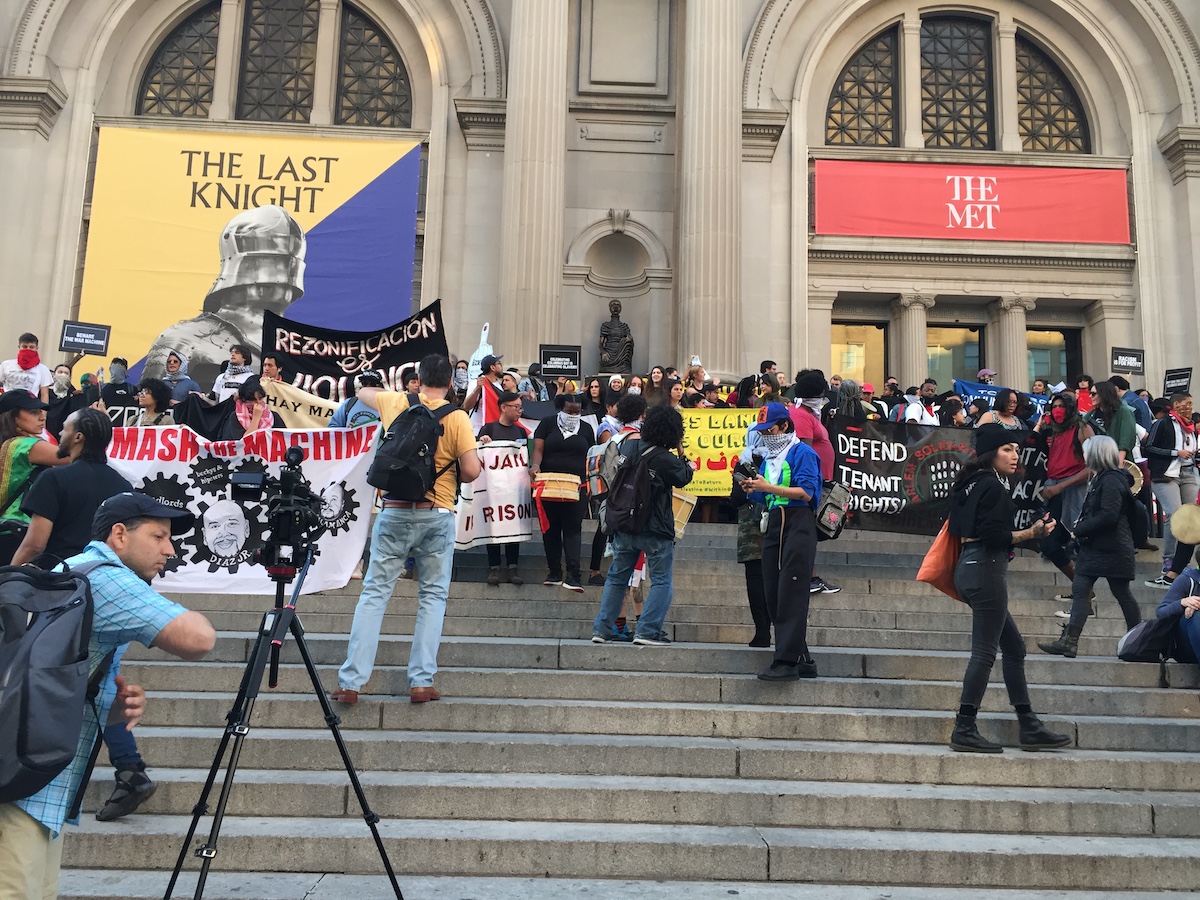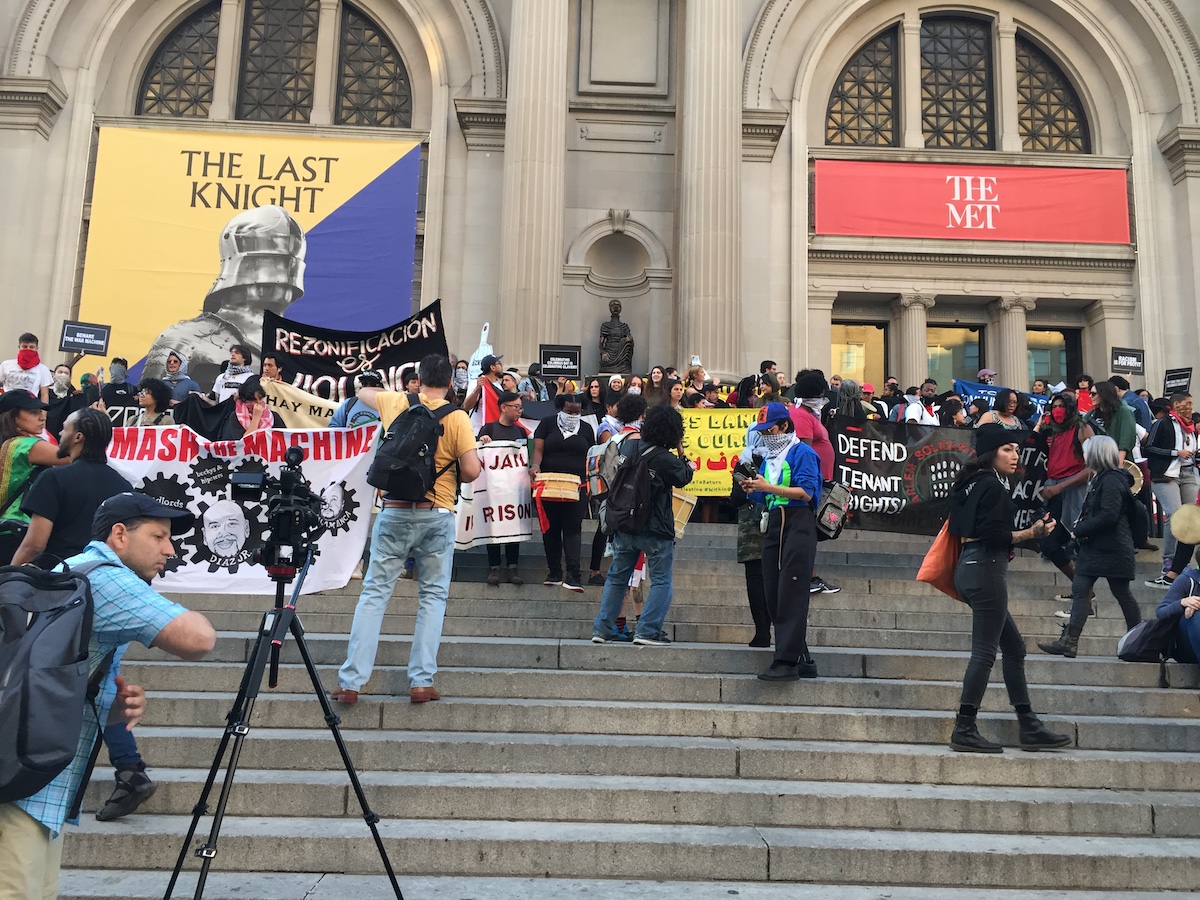[ad_1]

Protestors on the steps of the Metropolitan Museum of Art in New York on October 14, 2019.
ALEX GREENBERGER/ARTNEWS
As the sun began to set on Monday, hundreds of protestors took to the stairs of the Metropolitan Museum of Art in New York. Many carried with them signs that mentioned Palestine, Kashmir, Standing Rock, and elsewhere, and many more brought banners condemning various forms of racism and out-of-control capitalism.
The huge crowd of demonstrators were there as part of an action held on the occasion of Indigenous Peoples’ Day, the holiday that began as a protest against Columbus Day in the United States some 30 years ago. Activists have used it to celebrate the indigenous peoples who preceded Columbus’s arrival in North America and who were subjugated after it. The action was part of an event led by the group Decolonize This Place (the group that staged the highly visible recent protests at the Whitney), in collaboration with a number of other organizations, that throughout the afternoon involved a tour of New York sites related to histories of colonialism and displacement.
Things had kicked off earlier in the day at the American Museum of Natural History, where there is a monument to former U.S. President Theodore Roosevelt on horseback, with a Native American man and a man of African descent at his sides. In a flyer handed out at the event, activists called Roosevelt “an imperialist” and “an eugenicist.” Also visited by the protesters as part of the day were the former location of Seneca Village, a slice of Central Park from which the Lenape people and, later, a black community were displaced; the Great Lawn, a picturesque section of the park from which soaring skyscrapers and other symbols of gentrification are visible; and Cleopatra’s Needle, a 12th-century Egyptian obelisk brought to New York in the 19th century at the command of a U.S. naval officer.
At various points, representatives for Decolonize This Place, Take Back the Bronx, No New Jails, Mi Casa Es Su Casa, and other groups described museums as bastions of harmful ideologies, in particular colonialism. After acknowledging that they were on Lenape land, many protestors chanted, “They want the art, but not the people!” Some brought signs reading, “Under the museums / Under the university / Under the city / THE LAND.”
After visiting each of these sites, protestors snaked through Central Park to reach the Met’s stairs, where a quintet of children from Ecuador performed music and various activists spoke. Framed by banners advertising an Alicja Kwade rooftop exhibition and a show of arms and armor from the reign of Emperor Maximilian I, Amin Husain, a member of Decolonize This Place, addressed the crowd. “I want to remind you that this was not brought to you by the Met,” he said of the event. “This was brought to you by the comrades who came together to say Columbus Day is a sham.”
A representative for the Met did not immediately respond to a request for comment on the action.
Prior Decolonize This Place protests have targeted specific board members and funders—at the Whitney Museum, for example, the protests called out Warren B. Kanders, the vice chair of the museum’s board, who resigned amid an outcry over his connections to a defense manufacturing company. Many have wondered whom the group will go after next, and the activists addressed these queries in a poster handed out at the event.
Under a heading titled “Anti-Capitalism: From the Museum to the City,” they wrote:
Now we are here at the Met, presided over by Daniel Brodsky, a member of the Real Estate Council of New York and leading oligarch of the city overall. Since Warren Kanders was removed from the Whitney, we have heard, over and over, “who is next?” From Brodsky to Larry Fink at MoMA, to Darren Walker at the Ford Foundation, no museum, no board member, no philanthropist, no member of the ruling class should feel safe right now.
A representative for Brodsky, the chairman of the Met’s board, did not immediately respond to a request for comment.
As the evening wound down, protestors split into three teach-in groups. Before they shared pizza on the steps of the Met, protestors were left with a message from Husain: “The fact that we’re in front of the Met is a message to wealthy people: They won’t be comfortable as long as our communities aren’t comfortable and safe.”
[ad_2]
Source link

